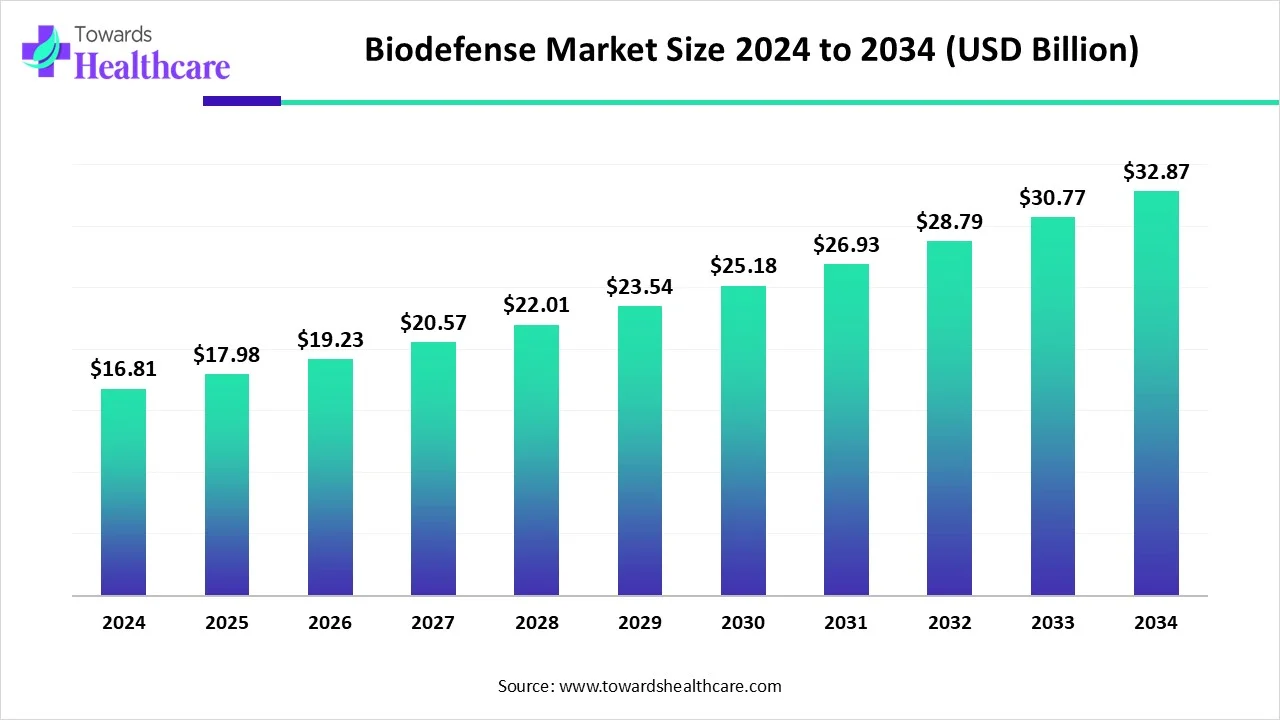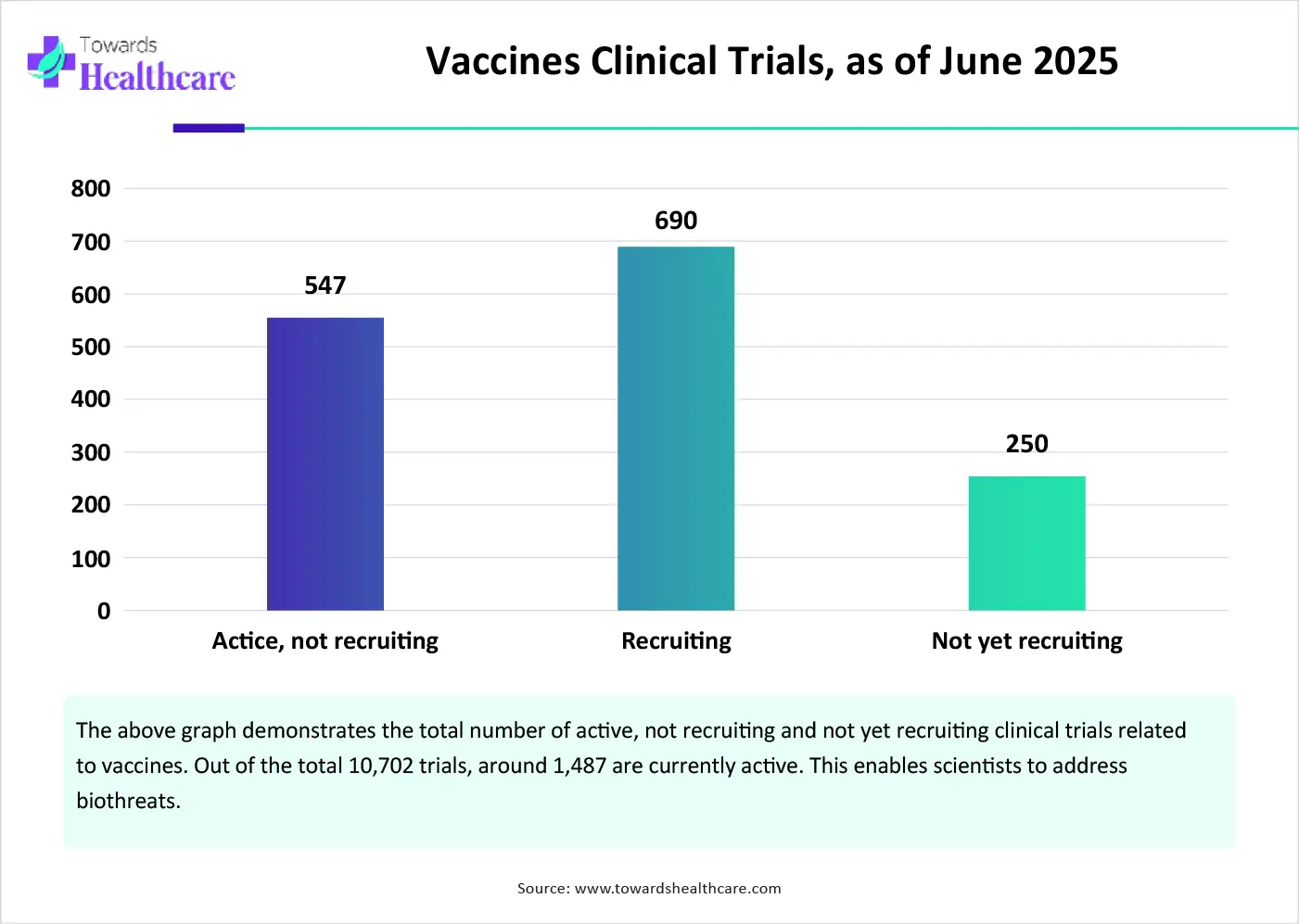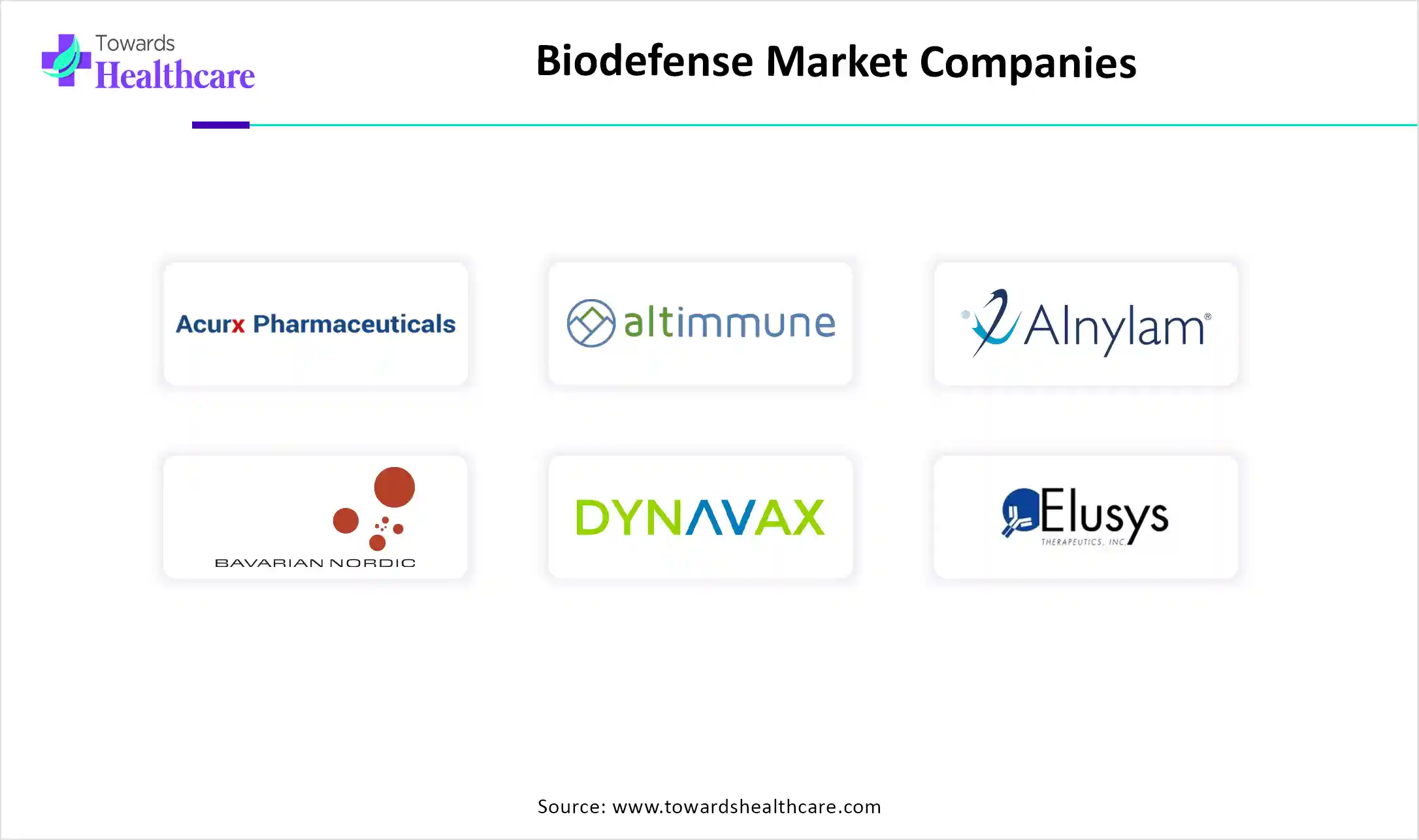December 2025

The global biodefense market size is calculated at USD 16.81 billion in 2024, grew to USD 17.98 billion in 2025, and is projected to reach around USD 32.87 billion by 2034. The market is expanding at a CAGR of 6.95% between 2025 and 2034.
The biodefense market is primarily driven by the increasing threat of bioterrorism and the rising prevalence of infectious disorders. Governments of various countries take several measures to address bioterrorism and biothreats. The growing research and development activities enable researchers to develop novel drugs and vaccines against pathogens. The R&D activities are supported by incentives and collaborations. The future looks promising, with advancements in technology supporting the development of biodefense mechanisms.

Biodefense refers to actions designed to counter biological threats, reduce risk, prepare for, respond to, and recover from bio incidents. Biothreats are either naturally occurring, deliberate, or accidental, and usually harm human, animal, plant, or environmental health. The medical measures that are taken to protect individuals include the development of interventions, such as drugs and vaccines, as well as research and public health preparations, as part of biodefense. Bioscience laboratories, agricultural managers, customs agents, and other departments use various processes and systems to prevent biothreats.
The market is fueled by various factors, including the rising prevalence of infectious diseases and growing awareness of biological threats. Favorable government initiatives help healthcare and other organizations to take necessary measures. The growing research and development activities and increasing investments boost the market. Technological advancements drive the latest innovations in the biodefense sector.
Artificial intelligence (AI) can transform the market by enabling professionals to develop novel solutions. It automates the entire research process, enhancing the efficiency and accuracy of research. AI allows researchers to develop drugs with higher efficacy and reduced side effects. AI and machine learning (ML) algorithms can screen vast amounts of data and suggest existing drugs with novel applications. Moreover, AI reasoning capabilities can detect biological misuse by combining automated systems with human reviewers. It can alert healthcare professionals about the potential biological threats. It can also suggest effective solutions to combat bioterrorism.
COVID-19 Pandemic
The major growth factor of the biodefense market is the recent outbreak of the COVID-19 pandemic. The coronavirus outbreak started spreading at the end of 2019 and became a pandemic in 2020. The WHO reported that more than 7 million people died due to COVID-19. (Source: WHO) Scientists developed vaccines to prevent coronavirus infections. However, numerous countries are experiencing a resurgence of COVID-19 cases. The major reason is the mutations in viral genomes. Countries in the Eastern Mediterranean, South-East Asia, and Western Pacific regions report an increase in SARS-CoV-2 activity since mid-February 2025. (Source: WHO)
High Cost
A significant challenge of the market is the high cost associated with developing and maintaining biodefense capabilities. Major technological advancements require high funding. This limits the affordability of numerous low- and middle-income countries.
What is the Future of the Biodefense Market?
The future of the market is promising, driven by growing research and development activities. Ongoing efforts are made to develop novel treatment regimens, such as drugs, vaccines, and other biological products, to cure biological threats. The increasing number of clinical trials is also a result of growing research activities. As of June 2025, about 10,702 clinical trials are registered on the clinicaltrials.gov website related to vaccines as an intervention. The development of novel treatment strategies enables scientists and healthcare professionals to deal with biological threats. The increasing investments by the government and private organizations support research activities.

By product type, the vaccines segment held a dominant presence in the market in 2024. This segment dominated because of the rising prevalence of infectious disorders and the growing need for preventing health emergencies. The Centers for Disease Control and Prevention (CDC) states that there are more than 25 safe and effective vaccines to prevent diseases, protect health throughout the lifespan. CDC also estimated that more than 50 million deaths would be prevented through immunization between 2021 and 2030. (Source: CDC.Gov)
By product type, the therapeutics segment is expected to grow at the fastest CAGR in the market during the forecast period. The growing research and development activities lead to the development of novel therapeutics. Therapeutics, such as drugs and medical devices, help treat or mitigate infectious disorders. They are crucial, especially when prevention through vaccination is not possible or when a threat agent is unknown.
By technology, the genetic engineering segment led the global market in 2024. This is due to the growing genomics research and advancements in genomic technologies. Genetic engineering enables researchers to study the disease progression and the spread of infections. It also allows researchers to develop novel biological products or vaccines for the prevention, diagnosis, and treatment of infectious disorders or biological threats. The burgeoning biotechnology sector also boosts the segment’s growth. Advancements in genetic engineering techniques, such as next-generation sequencing and CRISPR-Cas9, facilitate the creation of biologics.
By technology, the nanotechnology segment is expected to grow with the highest CAGR in the market during the studied years. Nanotechnology is an emerging field used for the development of novel drug delivery systems. It helps to develop targeted therapy to enhance therapeutic outcomes and reduce systemic side effects. It has applications in diverse sectors, including diagnostics, therapeutics, regenerative medicine, and gene therapy. Advancements in nanotechnology augment the segment’s growth.
By application, the medical countermeasures segment held the largest revenue share of the market in 2024. The segmental growth is attributed to the growing need to tackle public health emergencies and favorable regulatory policies. Medical countermeasures (MCMs) are products that prevent, protect, treat, or diagnose diseases or health effects caused by biological threats. Some common examples of MCMs include biological products (vaccines, blood products, antibodies), medical devices, and drugs. Government and private organizations support the development of novel MCMs through funding.
By application, the decontamination segment is expected to witness significant growth in the market over the forecast period. Decontamination is a process or treatment that renders a medical device, instrument, or environmental surface safe to handle. The different forms of decontamination are sterilization, disinfection, and antisepsis. Decontamination is essential for preventing the spread of harmful substances, thereby reducing the risk of biological threats. It is necessary when appropriate treatment regimens are unavailable for a particular disease.
North America dominated the global market in 2024. The availability of state-of-the-art research and development facilities, favorable government support, and technological advancements are the major growth factors of the market in North America. Government organizations provide funding for advanced research activities. Favorable regulatory policies facilitate the launch of novel products.
The National Biodefense Strategy by the U.S. government aims to counter biological threats, enhance pandemic preparedness, and achieve global health security. The Trump Administration has recently assumed responsibility for leadership and action on biodefense. The DoD’s Generative Unconstrained Intelligent Drug Engineering (GUIDE) program focuses on harnessing supercomputing abilities to design and evaluate MCMs faster than conventional methods. (Source: https://councilonstrategicrisks.org/2025/02/04/bolstering-us-biodefense-recommendations-for-the-new-administration/)
The Canadian government has formed the Centre for Biosecurity (CB) to protect the health, safety, and security of Canadians from the risks of human pathogens, animal pathogens, and microbial toxins. (Source: https://www.canada.ca/en/public-health/services/laboratory-biosafety-biosecurity/about-centre-biosecurity.html) In September 2023, the Coalition for Epidemic Preparedness Innovations (CEPI) announced a collaboration with Global Affairs Canada with funding of CAD 1 million to accelerate the development of vaccines, promoting CEPI’s biosecurity strategy. (Source: https://cepi.net/cepi-and-global-affairs-canada-deepen-collaboration-strengthen-international-biosecurity-and)
Asia-Pacific is expected to host the fastest-growing biodefense market in the coming years. The growing research and development activities and the burgeoning genomics and proteomics sectors augment the market. The increasing funding by government and private organizations and the rising collaborations among academic researchers and key players favor the market. People are becoming aware of the consequences of biological threats, thereby taking preventive measures.
Chinese researchers have detected a total of 24 notifiable infectious diseases in China before and after the COVID-19 pandemic. This poses a significant threat to public health. The National Medical Product Administration (NMPA) regulates the approval of biological products in China. In 2023, the NMPA approved a total of 82 novel therapeutics, of which 4 were vaccines. (Source: Article)
It is estimated that nearly 10 million die in India, of which more than 17% or 1.7 million people die due to communicable diseases. In November 2024, the Defense Research and Development Organization (DRDO) inaugurated a new Bio-Safety Level-4 (BSL-4) laboratory and a Bio-detector, Test & Evaluation Facility at the Defence Research and Development Establishment (DRDE) to enhance India’s chemical-biological defense capabilities. (Source: Times of India
Europe is expected to grow at a notable CAGR in the biodefense market in the foreseeable future. The increasing prevalence of infectious disorders and the rising adoption of advanced technologies boost the market. Favorable government support leads to the development of novel therapeutics. The funding cut by the Trump Administration for research purposes opens doors for American scientists in Europe, due to favorable research facilities and increasing investments.
The German government’s “The German Biosecurity Programme” aims to help partner countries to tackle biological threats, such as deliberate misuse of biological pathogens and toxins, and pandemics. The German government aims to fulfill 60% of Europe’s needs for routine vaccines through local production by 2040.
The UK government announced an investment of £1 billion in a new National Biosecurity Center to protect the British public and the economy from future pandemics. Disease incursions in the UK can severely impact farmers, agricultural production, and disrupt the supply chain. Annually, approximately £16 billion of the exports of livestock, meat and meat products, dairy, and animal by-products contribute to the UK’s economy. (Source: GOV.uk)

Ian Watson, Deputy Assistant Secretary of Defense for Chemical and Biological Defense, commented that the new supercomputing system and other technical enablers will help DoD build enduring advantages and deliver cutting-edge defensive capabilities that will ensure the Total Force can deter or prevail against advanced chemical and biological threats against the U.S. (Source: RTT News)
By Product Type
By Technology
By Application
By Region
December 2025
December 2025
December 2025
December 2025